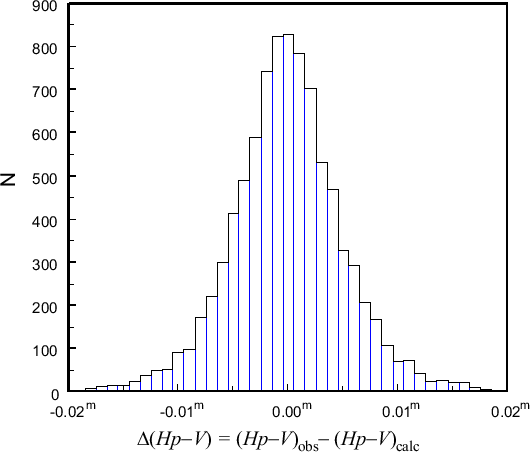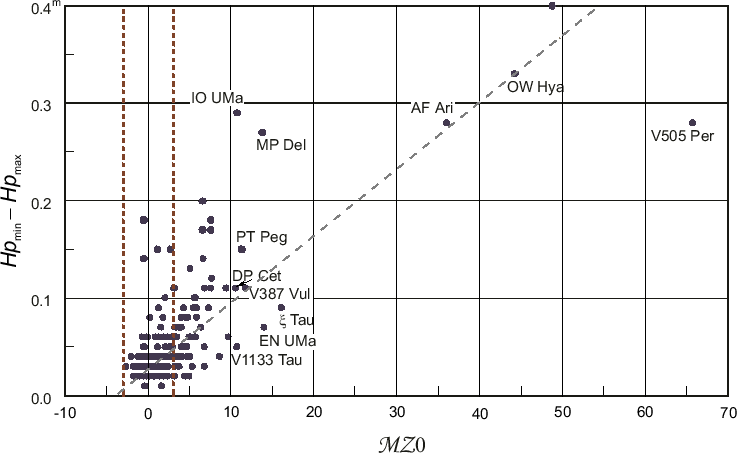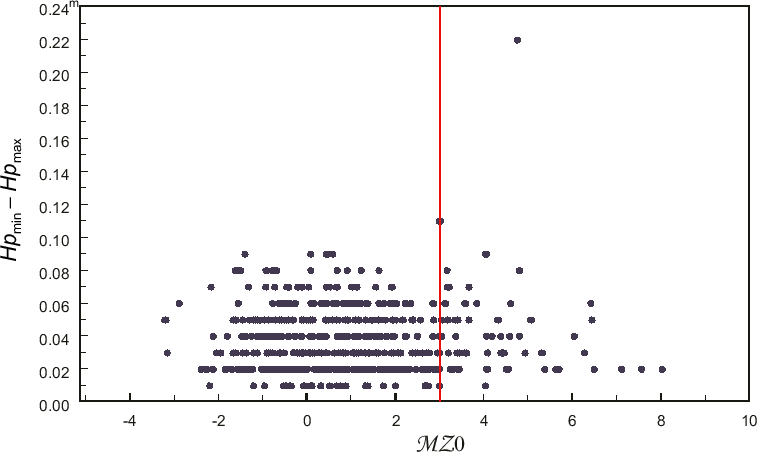WBVR Standards in the Northern Sky. Analysis of
Variability Using
 Technique
Technique
|
Peremennye Zvezdy (Variable Stars) 33, No. 8, 2013 Received 21 November; accepted 10 December.
N.L. Kroussanova, A.V. Mironov, A.I. Zakharov
Sternberg Astronomical Institute, Lomonosov Moscow
State University, 13, University Ave., Moscow 119991, Russia
|
Article in PDF |
1. Introduction
Kornilov et al. (1991) published "The Catalogue of
This comparison was performed using a special algorithm, so that
coefficients of the non-linear polynomial relating the ![]() difference to
difference to ![]() ,
, ![]() , and
, and ![]() color indices were
calculated. The comparison proved that the difference of the
observed
color indices were
calculated. The comparison proved that the difference of the
observed ![]() and that calculated using the polynomial,
and that calculated using the polynomial,
![]() , namely
, namely
![]() did not exceed
did not exceed
![]() for 8766 stars. The
frequency distribution of the differences is shown in Fig. 1. The
rms deviation is
for 8766 stars. The
frequency distribution of the differences is shown in Fig. 1. The
rms deviation is
![]() .
.
Obviously, the spectral energy distributions of these stars give a
possibility to calculate magnitudes in one catalog (Hipparcos)
from magnitudes in the other catalog ![]() rather accurately.
This property allows us to consider the stars of this sample as
candidate photometric standards in the northern sky. Since common
stars in the two catalogs were observed at different times, using
completely different methods, and from different positions (in
space and on the Earth), the close agreement between calculated
and observed values indicates that these stars are not variable
or, at least, have low variability amplitudes. However, to be
valuable standards, the stars should be carefully examined for
variability.
rather accurately.
This property allows us to consider the stars of this sample as
candidate photometric standards in the northern sky. Since common
stars in the two catalogs were observed at different times, using
completely different methods, and from different positions (in
space and on the Earth), the close agreement between calculated
and observed values indicates that these stars are not variable
or, at least, have low variability amplitudes. However, to be
valuable standards, the stars should be carefully examined for
variability.
Observations obtained during the Hipparcos mission and contained
in the "Hipparcos Epoch Photometry Annex" and "Tycho Epoch
Photometry Annex" lists provide such an opportunity. A technique
was developed in the SAI (Mironov et al. 2003) permitting to
discover brightness variations of stars on the basis of
simultaneous multichannel observations. According to this
technique, an ![]() parameter is calculated; this parameter
evaluates the degree of correlation of individual magnitude
measurements in several channels.
parameter is calculated; this parameter
evaluates the degree of correlation of individual magnitude
measurements in several channels.
Suppose that, for a star with the number ![]() in the pair of
channels with numbers
in the pair of
channels with numbers ![]() and
and ![]() , we have
, we have ![]() simultaneous
observations. Then we can calculate the linear correlation
coefficient, assuming a normal distribution of the variables
simultaneous
observations. Then we can calculate the linear correlation
coefficient, assuming a normal distribution of the variables ![]() and
and ![]() , according to the formula:
, according to the formula:
Since there exist ![]() channels, one can construct a vector
channels, one can construct a vector
![]() with
with
![]() components being generally correlated. From components of the
vector, one can calculate an integrated statistics
components being generally correlated. From components of the
vector, one can calculate an integrated statistics ![]() for
every star:
for
every star:
Note that
![]() does not mean that the
star cannot be considered variable. It only means that the
Hipparcos material is not good enough to discover its variability.
This is primarily due to the fact that the standard error of
measurements in the
does not mean that the
star cannot be considered variable. It only means that the
Hipparcos material is not good enough to discover its variability.
This is primarily due to the fact that the standard error of
measurements in the ![]() and
and ![]() channels is large (about
channels is large (about
![]() ).
).
2. Taking into Account Correlation Between Channels
Initially, we selected 8766 stars with
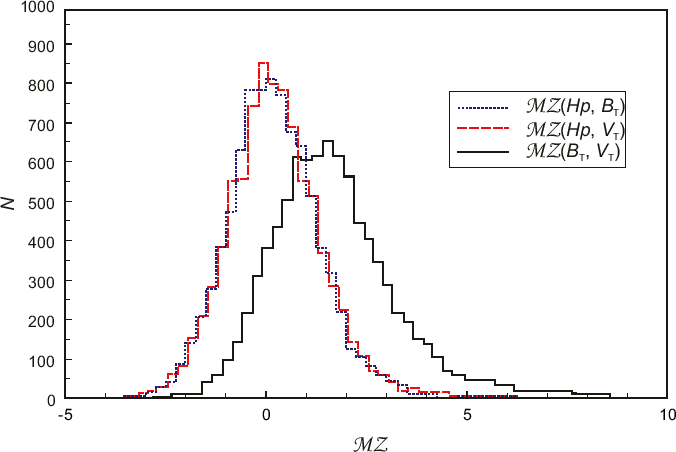 |
Fig. 2.
Histograms of the three |
Most stars of our sample are not variables; nevertheless, their
distribution modes are not zero, as it should be for independent
random variables. For the pair of ![]() and
and ![]() , the mode was
found to be 0.11865; for the pair of
, the mode was
found to be 0.11865; for the pair of ![]() and
and ![]() , 0.1672; and
for the pair of
, 0.1672; and
for the pair of ![]() and
and ![]() , 0.8047. Thus, all the channels
are correlated. The same conclusion was earlier made from other
considerations (Zakharov et al. 2000; Krutyakov et al. 2000). The
correlation for the channel pairs
, 0.8047. Thus, all the channels
are correlated. The same conclusion was earlier made from other
considerations (Zakharov et al. 2000; Krutyakov et al. 2000). The
correlation for the channel pairs ![]() and
and ![]() ,
, ![]() and
and ![]() is poor, but for the pair of
is poor, but for the pair of ![]() and
and ![]() it is strong enough.
The presence of a correlation shifts the
it is strong enough.
The presence of a correlation shifts the ![]() parameter from
zero, even when there is no true variability. Before calculating
the generalized statistics
parameter from
zero, even when there is no true variability. Before calculating
the generalized statistics ![]() according to formula
(6), it is necessary to take into account the
influence of the cross-correlation and to subtract corresponding
values of the distribution modes, found for non-variable stars,
from the obtained
according to formula
(6), it is necessary to take into account the
influence of the cross-correlation and to subtract corresponding
values of the distribution modes, found for non-variable stars,
from the obtained
![]() , getting
, getting
![]() and
and
![]() . The corrected
data points are denoted
. The corrected
data points are denoted
![]() ,
, ![]() ,
,
![]() , and generalized as
, and generalized as ![]() .
.
3. Stars of Our Sample Listed as Variables in the GCVS and NSV Catalogs and the AAVSO VSX Database
An analysis of the ![]() statistics for the stars identified
as variables allows us to estimate the effectiveness of the
statistics for the stars identified
as variables allows us to estimate the effectiveness of the
![]() technique for discovering low-amplitude stars on the
base of Hipparcos and Tycho data.
technique for discovering low-amplitude stars on the
base of Hipparcos and Tycho data.
First, consider the stars with GCVS names. There are 181 of them in our sample of 8636 stars.
The fields H49-50 in the Hipparcos catalog contain respectively
the 5th and 95th percentiles of the epoch photometry, i.e.
![]() (0.05) and
(0.05) and ![]() (0.95). Thus, they provide an estimate of the
magnitudes at maximum and minimum brightness detected during the
time of observations.
(0.95). Thus, they provide an estimate of the
magnitudes at maximum and minimum brightness detected during the
time of observations.
We compared the
![]() differences to
the
differences to
the ![]() parameter. The results for the 181 GCVS stars
are shown in Figs. 3, 5, and 7.
parameter. The results for the 181 GCVS stars
are shown in Figs. 3, 5, and 7.
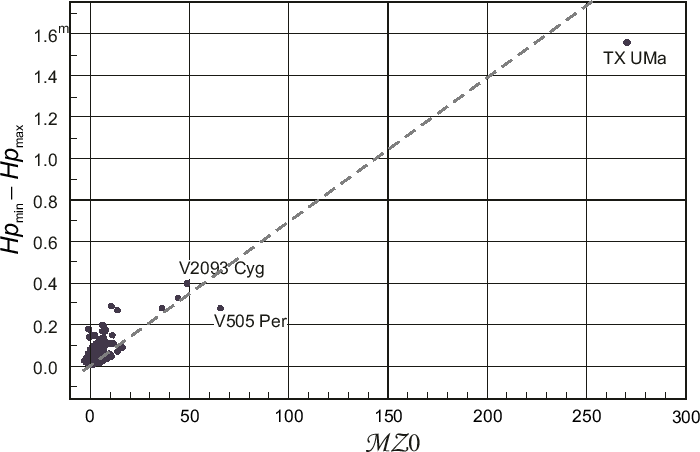 |
Fig. 3.
The relation between |
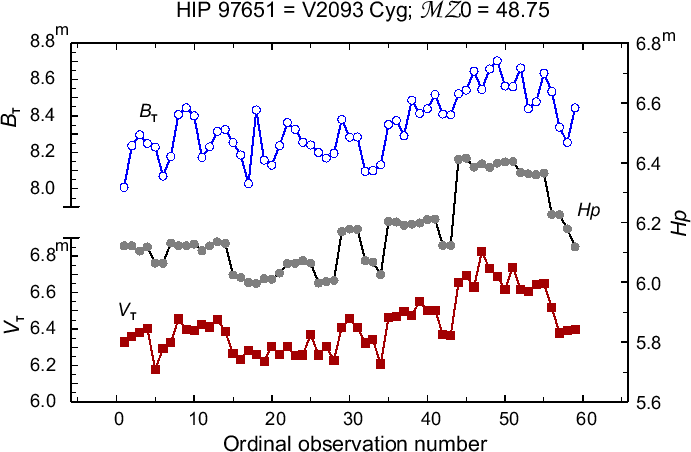 |
Fig. 4.
The light curves of the variable V2093 Cyg in the |
Figure 3 shows that most points are grouped in an area where
![]() does not exceed 10 and the
does not exceed 10 and the
![]() difference is not larger than
difference is not larger than
![]() . The highest values of
. The highest values of
![]() were found for the stars TX UMa, V505 Per, and
V2093 Cyg. TX UMa is an eclipsing system of the EA/SD type. It has
an amplitude of
were found for the stars TX UMa, V505 Per, and
V2093 Cyg. TX UMa is an eclipsing system of the EA/SD type. It has
an amplitude of
![]() in
in ![]() band and the period
band and the period
![]() .
It is clear that the star was observed by Hipparcos in different
phases and is easily detected by the
.
It is clear that the star was observed by Hipparcos in different
phases and is easily detected by the ![]() technique. The
eclipsing variable V505 Per belongs to the EA/DM type, its
amplitude being
technique. The
eclipsing variable V505 Per belongs to the EA/DM type, its
amplitude being
![]() . Hipparcos observed four eclipses,
permitting the
. Hipparcos observed four eclipses,
permitting the ![]() technique to detect the variability
reliably. V2093 Cyg has the type LB and an amplitude of
technique to detect the variability
reliably. V2093 Cyg has the type LB and an amplitude of
![]() .
As an example, the light curve of V2093 Cyg is shown in Fig. 4.
Synchronous brightness changes in the three channels are clearly
seen.
.
As an example, the light curve of V2093 Cyg is shown in Fig. 4.
Synchronous brightness changes in the three channels are clearly
seen. ![]() is about 50; this value is very reliable and
indicates that the star is variable.
is about 50; this value is very reliable and
indicates that the star is variable.
The area of
![]() is shown in more detail in Fig. 5.
is shown in more detail in Fig. 5.
The variables in the
![]() range are marked in
the figure. The figure convinces us that the
range are marked in
the figure. The figure convinces us that the ![]() -technique
makes it possible to discover such variables as OW Hya, AF Ari,
IO UMa, and MP Del without difficulties. These stars are eclipsing
variables with amplitudes not exceeding
-technique
makes it possible to discover such variables as OW Hya, AF Ari,
IO UMa, and MP Del without difficulties. These stars are eclipsing
variables with amplitudes not exceeding
![]() . More
interesting are the discoveries of EN UMa (DSCTC, amplitude
. More
interesting are the discoveries of EN UMa (DSCTC, amplitude
![]() ) and V1133 Tau (LPB, amplitude
) and V1133 Tau (LPB, amplitude
![]() ). They confirm
that the method is able to detect variability with amplitudes
below the standard error in most channels. The light curve of
EN UMa is shown in Fig. 6.
). They confirm
that the method is able to detect variability with amplitudes
below the standard error in most channels. The light curve of
EN UMa is shown in Fig. 6.
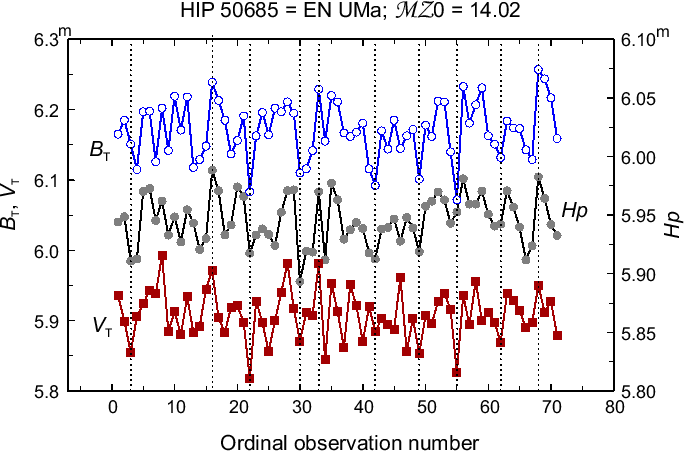 |
Fig. 6.
Brightness of EN UMa in the |
Figure 7 shows, in most detail, the area of the smallest
![]() values.
values.
It follows from Fig. 7 that if
![]() , then, according
to the theory, we should expect the star to be variable. 54 stars
are situated in the
, then, according
to the theory, we should expect the star to be variable. 54 stars
are situated in the
![]() range. The area of
range. The area of
![]() mainly contains variables with amplitudes of
mainly contains variables with amplitudes of
![]() . They are not detected, primarily
because of large errors in the
. They are not detected, primarily
because of large errors in the ![]() and
and ![]() channels.
channels.
Figure 8 shows the light curve of ![]() Eri. The star's
variability type is BY. Despite the small number of observations
(only 9 reliable simultaneous measurements in
Eri. The star's
variability type is BY. Despite the small number of observations
(only 9 reliable simultaneous measurements in ![]() ,
, ![]() , and
, and
![]() ), there is a strong correlation.
), there is a strong correlation.
Thus, on the base of simultaneous measurements in individual ![]() ,
,
![]() , and
, and ![]() bands of the Hipparcos experiment, from 174 GCVS
stars having
bands of the Hipparcos experiment, from 174 GCVS
stars having
![]() below
below
![]() , the
, the ![]() technique found 43 variables (25%) at
technique found 43 variables (25%) at
![]() and 59
variables (34%) at
and 59
variables (34%) at
![]() .
.
Consider now the stars of our sample contained in the NSV list.
There are 504 such stars. They all lie in the
![]() range. Their positions in the
range. Their positions in the
![]() diagram are shown in Fig. 9. The following
distribution of
diagram are shown in Fig. 9. The following
distribution of ![]() was found for these 504 stars:
was found for these 504 stars:
| Number of stars | |
|
|
164 |
|
|
112 |
|
|
106 |
|
|
62 |
|
|
28 |
|
|
20 |
|
|
13 |
| Total | 504 |
Among the stars under consideration,
![]() for 123
objects (24.4%);
for 123
objects (24.4%);
![]() for 61 stars (12%);
for 61 stars (12%);
![]() for 33 stars; and
for 33 stars; and
![]() for 13 stars.
Many of these stars should actually be variable. For example, the
relation of
for 13 stars.
Many of these stars should actually be variable. For example, the
relation of ![]() ,
, ![]() ,
, ![]() on the serial number of
observation for NSV 24420 = HIP 89981 is shown in Fig. 10, and a
similar relation for NSV 24923 = HIP 97757, in Fig. 11.
on the serial number of
observation for NSV 24420 = HIP 89981 is shown in Fig. 10, and a
similar relation for NSV 24923 = HIP 97757, in Fig. 11.
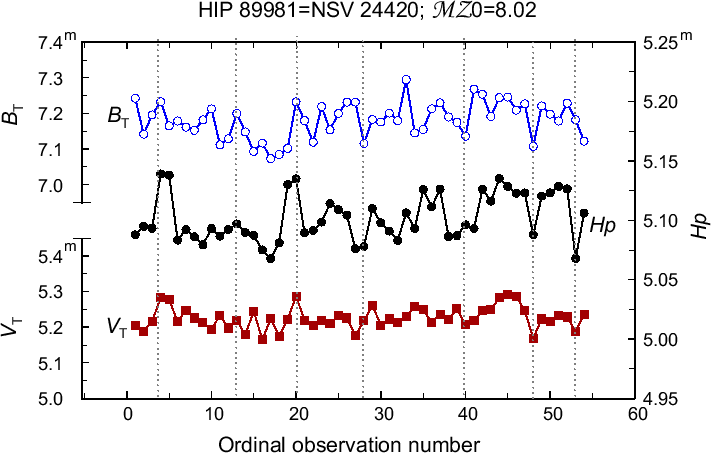 |
Fig. 10.
Simultaneously measured |
 |
Fig. 11.
Simultaneously measured |
Both diagrams show repeated simultaneous deviations of brightness from the mean values.
Among the 504 NSV stars, 467 are listed in the AAVSO VSX database; 47 NSV stars do not enter the AAVSO list. The latter stars have the following NSV numbers:
| 02990, | 05426, | 09915, | 13336, | 15165, | 15478, | 15594, | 15755, | 15816, | 16228, |
| 16351, | 16353, | 16390, | 16738, | 16744, | 17418, | 17882, | 18090, | 19580, | 19751, |
| 19940, | 20099, | 20109, | 20215, | 20429, | 20619, | 20902, | 20927, | 23672, | 23850, |
| 24040, | 24405, | 24406, | 24626, | 24669, | 24848, | 24872, | 24881, | 24891, | 24943, |
| 25003, | 25772, | 25781, | 25891, | 25922, | 25999, | 26115. |
The numbers in boldface are stars with
![]() .
.
Let us now consider briefly the stars from the AAVSO list. Among the 8636 stars in our sample, 792 stars enter the AAVSO Variable Star Index (VSX). 632 of them have GCVS names or NSV numbers (173 and 459 stars, respectively). 160 AAVSO stars are present neither in the GCVS nor in the NSV catalog, while 140 of them, according to the AAVSO data, are periodic variables with known periods.
Of the 181 stars listed in the GCVS, 8 stars are not contained in the VSX. We present these stars, with their MZ0 values, in Table 1.
| star | MV Dra | V0668 Lyr | V0831 Her | EZ UMa |
| -0.695 | -0.512 | 0.894 | 1.304 | |
|
|
||||
| star | FX UMa | V0917 Ori | V0449 Aur | DP Cet |
| 4.704 | 0.244 | 5.673 | 10.596 | |
|
|
The table shows that the ![]() -technique confirms the
variability only for FX UMa, V0449 Aur, and DP Cet, but it should
be remembered that using Hipparcos data for stars with amplitudes
that low permits to detect only about 20% of all variables by
means of the
-technique confirms the
variability only for FX UMa, V0449 Aur, and DP Cet, but it should
be remembered that using Hipparcos data for stars with amplitudes
that low permits to detect only about 20% of all variables by
means of the ![]() technique.
technique.
4. An Analysis of the Variability Flags in the Hipparcos Catalog
First, we quote the description of the variability characteristics (flags in the field H52), as it is given in the documentation of the Hipparcos catalog.
"C" : "constant" stars or, more strictly, stars not detected as variable. These include stars used as photometric standards. The category also included cases noted as variable in the Hipparcos Input Catalogue. Caution must be exercised in assuming that entries flagged "C" are non-variable: they may be variable at levels below the Hipparcos detectability threshold, or they may have shown variability in the past (e.g. Be stars, or long-period eclipsing binaries);
"D": a "duplicity-induced variability" flag was assigned
according to the difference between the "dc" and "ac"
magnitudes and according to the angular separation and magnitude
difference of a double or multiple system. If "D" is set the
entry is not necessary a physical variable, and not necessary seen
as variable in ![]() ("dc scale");
("dc scale");
"M": "possibly micro-variable", with amplitude below 0.03 mag (stars classified with high confidence as micro-variable are flagged "U");
"P": "periodic variable". This flag may supersede entries for which flag "D" is also appropriate;
"R": "revised colour index". When the flag "R" is set the ![]() index was corrected during the variability analysis, The
effect of an erroneous
index was corrected during the variability analysis, The
effect of an erroneous ![]() index is a spurious linear trend in
the
index is a spurious linear trend in
the ![]() magnitude of the epoch photometry, with no physical
origin. When identified during the data analysis, this could be
taken into account in classifying the type of variability, i.e.
whether spurious or not;
magnitude of the epoch photometry, with no physical
origin. When identified during the data analysis, this could be
taken into account in classifying the type of variability, i.e.
whether spurious or not;
"U": "unsolved variable". Entries are classified as "unsolved" if they do not fall into the other variability categories - this class also includes irregular or semi-irregular variables, and possible variables with amplitudes more than 0.03 mag;
"![]() ": a "blank" indicates that the entry could not be
classified as variable or constant with any degree of certainty
(e.g. due to presence of one of more outliers in the epoch
photometry).
": a "blank" indicates that the entry could not be
classified as variable or constant with any degree of certainty
(e.g. due to presence of one of more outliers in the epoch
photometry).
181 GCVS stars of our sample have the following types of variability by Hipparcos:
| " |
39 |
| "M" (possibly micro-variable) | 13 |
| "P" (periodic variable) | 49 |
| "U" (unsolved variable) | 58 |
| "C" (constant) | 22 |
22 stars are of type "C". They are V1728 Aql, AY Ari, KZ Cam,
AV Cap, HT Cet, EP Cnc, KX Cnc, KU Com, LW Com, LS Com, LU Del,
V0377 Gem, V0831 Her, V0401 Hya, HR Lib, V2711 Oph, V1260 Ori,
V0400 Peg, BU Psc, PV UMa, FI UMa and EV Vir. All these stars have
![]() , therefore, the
, therefore, the ![]() technique, strictly
speaking, does not permit to establish variability of these stars
based on the results of Hipparcos and Tycho photometry.
technique, strictly
speaking, does not permit to establish variability of these stars
based on the results of Hipparcos and Tycho photometry.
Among the 49 stars of "P" type, 33 stars have
![]() ,
and 29 of them have
,
and 29 of them have
![]() . Thus, the
. Thus, the ![]() technique confirms variability for most "P"-type stars.
technique confirms variability for most "P"-type stars.
Among the 58 stars of "U" type, 34 stars have
![]() ,
and their variability is not in doubt. V2093 Cyg has the largest
parameter,
,
and their variability is not in doubt. V2093 Cyg has the largest
parameter,
![]() .
.
Among the 13 stars of "M" type, three stars have large
probabilities to be variable. These are ![]() Eri (see
Fig 8),
Eri (see
Fig 8), ![]() Vir,
Vir, ![]() Aqr. For these stars,
Aqr. For these stars,
![]() . All the others have
. All the others have
![]() .
.
39 stars of the "blank" type have ![]() values ranging
from
values ranging
from ![]() to
to ![]() . Only two stars have
. Only two stars have
![]() ,
and 3 stars have
,
and 3 stars have
![]() . It appears that most stars of
the "blank" type are not variable.
. It appears that most stars of
the "blank" type are not variable.
5. Selection of Stars That Are Most Likely Non-variable
We have decided that, in spite of the particular
![]() -parameter, all stars contained in the GCVS, NSV
catalog, in the AAVSO VSX database, or having the "U", "P",
"D", and "M" Hipparcos variability types, as well as stars for
which we are not able to calculate the
-parameter, all stars contained in the GCVS, NSV
catalog, in the AAVSO VSX database, or having the "U", "P",
"D", and "M" Hipparcos variability types, as well as stars for
which we are not able to calculate the ![]() parameter,
should be excluded from the candidate standard stars. A total of
7249 stars was left at this stage.
parameter,
should be excluded from the candidate standard stars. A total of
7249 stars was left at this stage.
Our further examination showed that there were numerous cases of
stars with only one value:
![]() , or
, or
![]() , or
, or
![]() , considerably in
excess of 3, while the other parameters were within 2, or maybe
even negative. Most often, we encounter
, considerably in
excess of 3, while the other parameters were within 2, or maybe
even negative. Most often, we encounter
![]() , while
, while
![]() and
and
![]() do
not suggest simultaneous brightness variations. An example of
deviations that are not due to the star's variability but to other
causes is shown in Fig. 12. Such cases require additional future
analysis.
do
not suggest simultaneous brightness variations. An example of
deviations that are not due to the star's variability but to other
causes is shown in Fig. 12. Such cases require additional future
analysis.
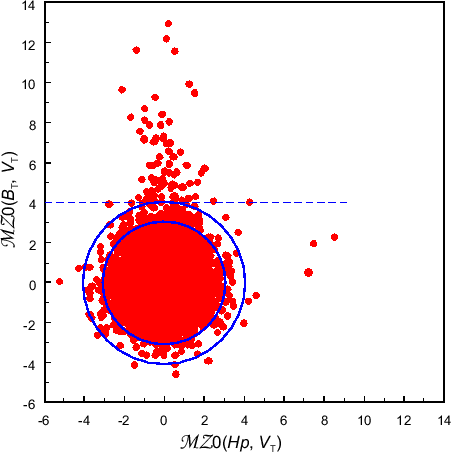 |
Fig. 12.
An example of the relation of
|
As a result, we have decided to exclude all stars that have
![]() as well as those for which at least one of the
parameters,
as well as those for which at least one of the
parameters,
![]() ,
,
![]() , or
, or
![]() exceeds 3, from the list of the
7249 candidate standards. Thus, the list of candidates was
reduced to 6484 stars. This list is given in Table 2. The columns of
the Table contain HIP numbers; HD numbers; RA(J2000), DE(J2000);
spectral types from the Hipparcos catalog;
exceeds 3, from the list of the
7249 candidate standards. Thus, the list of candidates was
reduced to 6484 stars. This list is given in Table 2. The columns of
the Table contain HIP numbers; HD numbers; RA(J2000), DE(J2000);
spectral types from the Hipparcos catalog; ![]() magnitudes,
magnitudes, ![]() ,
,
![]() , and
, and ![]() color indices from the Tien Shan catalog; and the
color indices from the Tien Shan catalog; and the
![]() parameters.
parameters.
We recommend to use these stars as standards in various astrophotomeric measurements.
6. Conclusion
With the exception of the "Hipparcos Epoch Photometry Annex" and "Tycho Epoch Photometry Annex" catalogs, there is no published data on individual simultaneous measurements of stellar magnitudes for extensive lists of stars. Using the data obtained in the Hipparcos experiment is hampered by the presence of large errors in individual measurements in theReferences:
ESA, 1977, Hipparcos and Tycho catalogues
Kornilov, V.G., Volkov, I.M., Zakharov, A.I., et al. 1991, Transactions of Sternberg Astron. Inst., 63, (ed. V.G. Kornilov), Moscow University Publishers
Krutyakov, A.N., Mironov, A.V., Zakharov, A.I. 2000, JENAM-2000, Symposium "Spectrophotometric and photometric catalogues. Standard stars and solar analogues", Proceedings, St. Petersburg University Press, p. 12
Mironov, A., Zakharov, A. 2002, Astrophys. & Space Sci., 280, 71
Mironov, A.V., Zakharov, A.I., Nikolaev, F.N. 2003 Baltic Astronomy, 12, 589
Perryman M.A.C., 2005, Proceedings of the Gaia Symposium "The Three-Dimensional Universe with Gaia", eds. C. Turon, K.S. O'Flaherty, M.A.C. Perryman, ESA SP-576 (European Space Agency), p. 15
Zakharov, A.I., Mironov, A.V., Krutyakov, A.N. 2000, "Variable Stars as a Key for Understanding of Galaxy Structure and Evolution", International conference. 1999, October 25-29, Moscow, Proceedings, eds. N.N. Samus and A.V. Mironov. "CYGNUS" Publishers, Nizhnij Arkhyz, p. 72
Zakharov, A.I., Mironov, A.V., Krutyakov, A.N. 2004, Transactions of Sternberg Astron. Inst., 70, 289
Zakharov, A.I., Mironov, A.V., Nikolaev, F.N., et al. 2013a, Astron. Nachrichten, 334, 823
Zakharov, A.I., Mironov, A.V., Prokhorov, M.E., et al. 2013b, Astronomy Reports, 57, 195
Zakharov, A.I., Mironov, A.V., Prokhorov, M.E., et al. 2013c, Astron. Nachrichten, 334, 828
